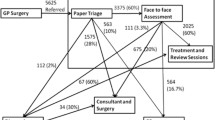Abstract
We report on the use of simulation modeling for redesigning phlebotomy and specimen collection centers (or patient service centers) at a medical diagnostic laboratory. Research was performed in an effort to improve patient service, in particular to reduce average waiting times as well as their variability. Discrete-event simulation modeling provided valuable input into new facility design decisions and showed the efficacy of pooling sources of variation, particularly patient demand and service times. Initial performance of the redesigned facilities was positive; however, dynamic feedback within the system of service centers eventually resulted in unanticipated performance problems. We show how a system dynamics model might have helped predict these implementation problems and suggest some ways to improve results.
Similar content being viewed by others
References
Ashton R, Hague L, Brandreth M, Worthington D, Cropper S (2005) A simulation-based study of a NHS walk-in centre. J Oper Res Soc 56:153–161
Stahl JE, Rattner D, Wiklund R, Lester J, Beinfeld M, Gazelle GS (2004) Reorganizing the system of care surrounding laparoscopic surgery: a cost-effectiveness analysis using discrete-event simulation. Med Decis Mak 24:461–471
Stafford EF Jr, Aggarwal SC (1979) Managerial analysis and decision-making in outpatient health clinics. J Oper Res Soc 30:905–915
Jun J, Jacobson S, Swisher J (1999) Application of discrete-event simulation in health care clinics: a survey. J Oper Res Soc 50:109–123
Swisher JR, Jacobson SH, Jun JB, Balci O (2001) Modeling and analyzing a physician clinic environment using discrete-event (visual) simulation. Comput Oper Res 28:105–125
Pasin F, Jobin MH, Cordeau JF (2002) An application of simulation to analyse resource sharing among health-care organisations. Int J Oper Prod Manage 22:381–393
Law AM, Kelton WD (2000) Simulation modeling and analysis, 3rd edn. McGraw-Hill, New York
Kleijnen J (1995) Verification and validation of simulation models. Eur J Oper Res 82:145–162
Arena, Version 5.00 (Rockwell Automation 2000)
Young T (2005) An agenda for healthcare and information simulation. Health Care Manage Sci 8:189–196
Brailsford SC, Lattimer VA, Tarnaras P, Turnbull JC (2004) Emergency and on-demand health care: modelling a large complex system. J Oper Res Soc 55:34–42
Lane DC, Monefeldt C, Rosenhead JV (2000) Looking in the wrong place for healthcare improvements: a system dynamics study of an accident and emergency department. J Oper Res Soc 51:518–531
Taylor K, Dangerfield B (2005) Modelling the feedback effects of reconfiguring health services. J Oper Res Soc 56:659–675
Sterman JD (2001) System dynamics modeling: tools for learning in a complex world. Calif Manage Rev 43(4):8–25
Kaldenberg DO, Becker BW (1999) Evaluations of care by ambulatory surgery patients. Health Care Manage Rev 24(3):73–83
Vensim, Version 5.4 (Ventana Systems, Inc. 2003)
Lane DC, Monefeldt C, Husemann E (2003) Client involvement in simulation model building: hints and insights from a case study in a London hospital. Health Care Manage Sci 6:105–116
Sterman JD (2000) Business dynamics: systems thinking and modeling for a complex world. McGraw-Hill, Boston, MA
Harper PR, Pitt MA (2004) On the challenge of healthcare modelling and a proposed project life cycle for successful implementation. J Oper Res Soc 55:657–661
Author information
Authors and Affiliations
Corresponding author
Rights and permissions
About this article
Cite this article
Rohleder, T.R., Bischak, D.P. & Baskin, L.B. Modeling patient service centers with simulation and system dynamics. Health Care Manage Sci 10, 1–12 (2007). https://doi.org/10.1007/s10729-006-9001-8
Published:
Issue Date:
DOI: https://doi.org/10.1007/s10729-006-9001-8




